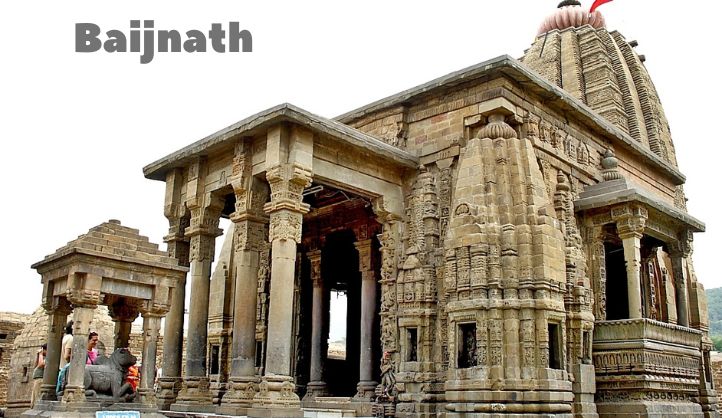About Baijnath:
- Geographical Overview:
- Baijnath is a town nestled in the Bageshwar district of Uttarakhand, India, located in the picturesque Kumaon region.
- Sacred Landscape:
- Situated along the banks of the Gomti River, Baijnath boasts a serene and scenic environment, enhancing its spiritual ambiance.
- Spiritual Significance:
- The town is renowned for the ancient Baijnath Temple, dedicated to Lord Shiva, making it a significant pilgrimage site in the region.
- Architectural Heritage:
- Baijnath showcases architectural marvels, with the Baijnath Temple dating back to the 12th century, reflecting the cultural and historical richness of the area.
History of Baijnath:
- Ancient Roots:
- Baijnath’s history can be traced to ancient times, with archaeological remnants indicating its cultural importance over the centuries.
- Baijnath Temple Construction:
- The Baijnath Temple, constructed in the 12th century, stands as a testament to the historical and religious evolution of Baijnath.
- Cultural Narratives:
- Inscriptions and cultural narratives contribute to the understanding of Baijnath’s role in the cultural and religious tapestry of Uttarakhand.
- Pilgrimage Legacy:
- Over the years, Baijnath has evolved into a revered pilgrimage destination, attracting devotees seeking spiritual fulfillment and divine blessings.
Why Baijnath is Famous:
- Baijnath Temple:
- The town is famous for the Baijnath Temple, a sacred shrine dedicated to Lord Shiva, drawing pilgrims and tourists alike.
- Architectural Grandeur:
- Baijnath’s fame is attributed to the architectural grandeur of the Baijnath Temple, showcasing intricate craftsmanship and historical significance.
- Cultural Heritage Hub:
- As a cultural heritage hub, Baijnath preserves and celebrates the cultural legacy of Uttarakhand, offering insights into the region’s historical past.
Things to Do in Baijnath:
- Visit Baijnath Temple:
- Explore the Baijnath Temple, marveling at its ancient architecture and experiencing the spiritual aura that surrounds this sacred site.
- Cultural Exploration:
- Immerse yourself in the local culture by interacting with residents, partaking in rituals, and gaining insights into the traditions of Baijnath.
- Nature Walks along Gomti River:
- Enjoy leisurely nature walks along the banks of the Gomti River, appreciating the scenic beauty that complements the spiritual atmosphere.
- Attend Religious Festivals:
- If visiting during religious festivals, participate in the vibrant celebrations to witness the cultural vibrancy of Baijnath.
Things to Know about Baijnath:
- Geographical Location:
- Baijnath is located in the Bageshwar district of Uttarakhand, India, situated in the Kumaon region along the banks of the Gomti River.
- Spiritual Significance:
- The town is renowned for the ancient Baijnath Temple, a sacred site dedicated to Lord Shiva, attracting pilgrims seeking spiritual solace.
- Historical Heritage:
- Baijnath boasts a rich historical heritage, with the Baijnath Temple dating back to the 12th century, showcasing architectural and cultural significance.
- Scenic Surroundings:
- Nestled in the Himalayan foothills, Baijnath offers a serene and picturesque environment, providing a peaceful retreat for visitors.
How to Reach Baijnath:
- By Air:
- The nearest airport is Pantnagar Airport, approximately 205 kilometers away. From the airport, one can hire a taxi or use public transportation to reach Baijnath.
- By Rail:
- The nearest railway station is Kathgodam Railway Station, around 180 kilometers away. From Kathgodam, one can travel by road to reach Baijnath.
- By Road:
- Baijnath is well-connected by road to major towns and cities in Uttarakhand. Regular buses and taxis operate on the route, providing convenient transportation options.
- Trekking from Nearby Towns:
- For adventure enthusiasts, Baijnath can be reached by trekking trails from nearby towns, offering a scenic and immersive journey.
Travel Tips for Baijnath:
- Pilgrimage Preparation:
- If visiting Baijnath for pilgrimage, ensure to carry necessary items like comfortable clothing, appropriate footwear, and any required offerings for the temple visit.
- Altitude Awareness:
- Baijnath is situated at an altitude, so it’s advisable to acclimatize gradually to prevent altitude-related issues, especially for those trekking in from lower altitudes.
- Local Customs and Etiquette:
- Respect local customs and etiquette, particularly when visiting religious sites. Dress modestly and seek guidance if uncertain about specific practices.
- Weather Considerations:
- Check the weather conditions before traveling, especially during the winter months when temperatures can be cold. Bring adequate clothing for varying weather.
Best Time to Visit Baijnath:
- Summer (March to June):
- Ideal for temple visits and outdoor activities, with pleasant weather and clear skies.
- Post-Monsoon (September to November):
- Another favorable time with clear views and comfortable temperatures, suitable for exploring Baijnath and its surroundings.
- Festive Season:
- Consider visiting during the festive season to witness cultural celebrations and experience the vibrant atmosphere of Baijnath.
Places to Eat Near Baijnath:
- Local Eateries in Baijnath:
- Explore the local eateries in Baijnath, offering authentic Kumaoni cuisine and traditional dishes, providing a taste of the regional flavors.
- Tea Stalls:
- Along the streets of Baijnath, tea stalls offer a refreshing break, allowing visitors to enjoy a cup of chai amidst the scenic surroundings.
- Dhabas on the Highway:
- Dhabas (roadside eateries) on the highways leading to Baijnath may serve simple yet delicious meals, making them convenient stops for travelers.
- Baijnath Market Cafés:
- Cafés in the Baijnath market area offer a variety of snacks and beverages, providing a relaxed setting for visitors to unwind.
- Temples and Pilgrimage Sites:
- Temples and pilgrimage sites in Baijnath may have small stalls offering prasad (religious offerings) or simple meals for devotees and tourists.
Nearby Places Baijnath:
- Bageshwar:
- Bageshwar, a nearby town, is known for its temples and scenic beauty, offering a spiritual and cultural experience for visitors.
- Kausani:
- Kausani, located not far from Baijnath, is renowned for its panoramic views of the Himalayas and is a popular hill station.
- Binsar:
- Binsar, known for the Binsar Wildlife Sanctuary, provides a tranquil retreat surrounded by forests and wildlife.
- Almora:
- Almora, with its historical significance and vibrant markets, offers a blend of cultural exploration and natural beauty.
- Chaukori:
- Chaukori, a picturesque hill station, is famous for its tea gardens and panoramic views of the Himalayan peaks.
Conclusion for Baijnath:
In conclusion, Baijnath stands as a captivating destination in Uttarakhand, blending spiritual sanctity with cultural heritage amidst the stunning landscapes of the Kumaon region. With its ancient temple, scenic beauty, and proximity to other notable places, Baijnath offers a holistic experience for pilgrims and travelers alike.
Frequently Asked Questions (FAQs) about Baijnath:
Q: What is the significance of the Baijnath Temple in Baijnath?
A: The Baijnath Temple is dedicated to Lord Shiva and holds historical and religious significance, attracting devotees seeking divine blessings.
Q: Are there trekking opportunities near Baijnath?
A: Yes, Baijnath serves as a base for trekking in the Himalayan foothills, providing opportunities for adventure enthusiasts.
Q: How far is Bageshwar from Baijnath, and what does it offer?
A: Bageshwar is a nearby town, approximately [mention distance], known for its temples and scenic beauty, providing cultural and spiritual experiences.
Q: What is the best time to visit Baijnath for a pilgrimage?
A: The best time for a pilgrimage to Baijnath is during the summer months (March to June) when the weather is pleasant for temple visits and outdoor activities.
Q: Are there accommodation options in Baijnath for tourists?
A: Yes, Baijnath offers various accommodation options, including guesthouses and hotels, catering to the needs of both pilgrims and tourists.





